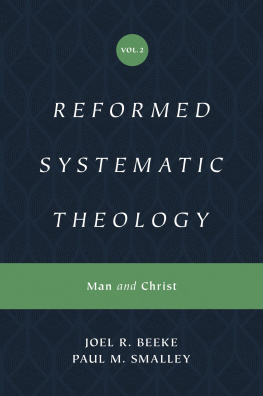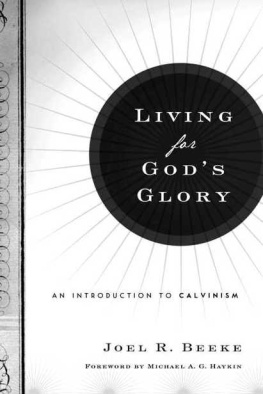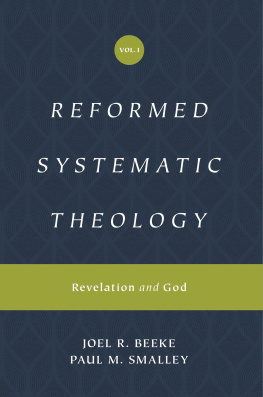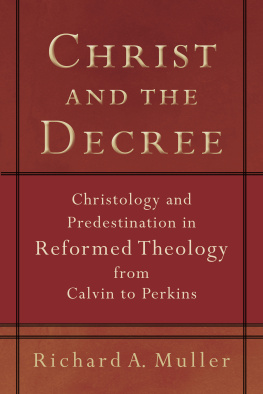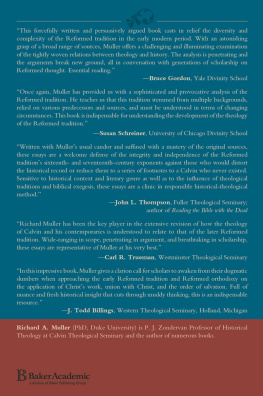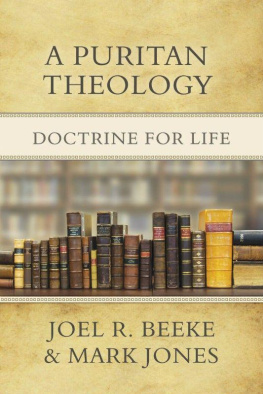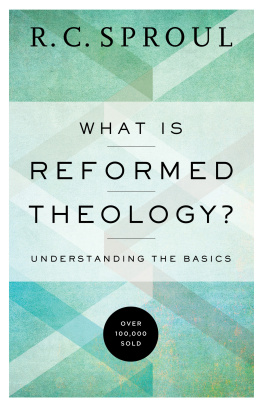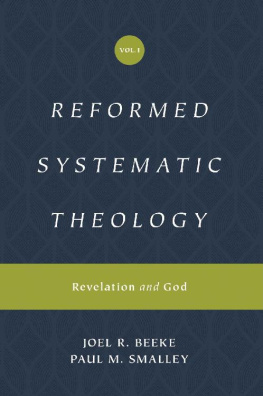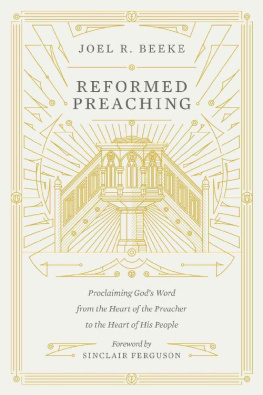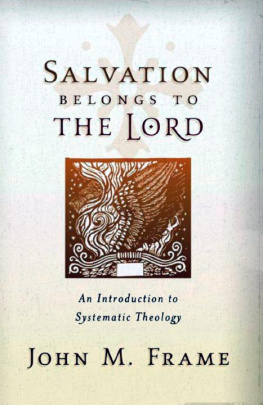Joel R. Beeke - Reformed Systematic Theology: Man and Christ
Here you can read online Joel R. Beeke - Reformed Systematic Theology: Man and Christ full text of the book (entire story) in english for free. Download pdf and epub, get meaning, cover and reviews about this ebook. year: 2020, publisher: Crossway, genre: Religion. Description of the work, (preface) as well as reviews are available. Best literature library LitArk.com created for fans of good reading and offers a wide selection of genres:
Romance novel
Science fiction
Adventure
Detective
Science
History
Home and family
Prose
Art
Politics
Computer
Non-fiction
Religion
Business
Children
Humor
Choose a favorite category and find really read worthwhile books. Enjoy immersion in the world of imagination, feel the emotions of the characters or learn something new for yourself, make an fascinating discovery.
- Book:Reformed Systematic Theology: Man and Christ
- Author:
- Publisher:Crossway
- Genre:
- Year:2020
- Rating:3 / 5
- Favourites:Add to favourites
- Your mark:
- 60
- 1
- 2
- 3
- 4
- 5
Reformed Systematic Theology: Man and Christ: summary, description and annotation
We offer to read an annotation, description, summary or preface (depends on what the author of the book "Reformed Systematic Theology: Man and Christ" wrote himself). If you haven't found the necessary information about the book — write in the comments, we will try to find it.
Reformed Systematic Theology: Man and Christ — read online for free the complete book (whole text) full work
Below is the text of the book, divided by pages. System saving the place of the last page read, allows you to conveniently read the book "Reformed Systematic Theology: Man and Christ" online for free, without having to search again every time where you left off. Put a bookmark, and you can go to the page where you finished reading at any time.
Font size:
Interval:
Bookmark:
Biblical Testimony to Christs Two States God testified to the humiliation and exaltation of his Son in various ways in the Old Testament. He revealed it in types, such as the enslavement, imprisonment, and elevation of Gods Son taught his disciples that the great theme of the Holy Scriptures is the humiliation and exaltation of the Christ: Ought not Christ to have suffered these things, and to enter into his glory? And beginning at Moses and all the prophets, he expounded unto them in all the scriptures the things concerning himself (Luke The apostles of Christ also bore witness to his two states. Peter summarizes the teachings of the ancient prophets about the Savior as the sufferings of Christ, and the glory that should follow (1 Pet. Steps in the State of Humiliation When we consider Christs state of humiliation, we must not view it merely as a situation to which he had to resign himself. Christ is God the Son, and as such, he could not suffer any abasement that he did not choose (Matt. We may consider the progress of Christs humiliation in several steps: incarnation, being made under the law, the circumstances of his conception and birth, childhood and early adulthood, public ministry, passion and death, burial, and descent into hell.
Reformed theologians differ on how to relate the incarnation to Christs humiliation. Some theologians favor counting the incarnation as the first step of humiliation. All of the degradations and difficulties that the incarnate Son experienced sprang from this root: he was under the law for us. 1:35). Christs birth took place in a low condition. 1).
The childhood and early adulthood of Jesus were neither easy nor elegant. He experienced the trauma of fleeing with his family to a foreign land in order to escape a violent death (Matt. Carpentry is a worthy trade by which people created in Gods image may fulfill the mandate to subdue the earth (Gen. Christ undertook a rigorous ministry of preaching, teaching, praying, healing, working miracles, and training apostles and evangelistsa ministry that brought him into direct conflict with the evil powers of this world. He grieved over the hardness of mens hearts (Mark Yet Jesus cast out demons, demonstrating that in Christ the kingdom of God had come and one stronger than Satan had arrived to conquer his evil kingdom (Luke The humiliation of Christ intensified greatly in his passion and death . While he celebrated his last Passover with his disciples, he taught them that his blood would be shed to ratify the new covenant with many sinners when God himself would strike him (Mark 14:24, 27).
Great distress and anguish seized him in the garden of Gethsemane, casting him down on the ground and threatening to end his life, yet as he prayed he submitted himself to his Fathers will (vv. 3236). One of the twelve apostles betrayed him to his enemies with a kiss, and another denied that he knew him (vv. 4345, 6672). False witnesses accused him before the Jewish Sanhedrin, and the council condemned him to death for claiming to be the Christ, spat on him, struck him, and mocked him (vv. 5765).
They took him to the Roman governor, whose soldiers scourged him, put a crown of thorns on his head, mocked him, and struck him (John 19:15). Pilate found no fault in him, but nevertheless handed him over to be crucified (vv. 4, 6, 16). 8:12) was eclipsed by darkness. 1:18). Thus, we may say with the Yet even in Christs death, God showed signs of his favor toward his Son that anticipated his exaltation.
His body was not left exposed to scavengers or dumped into a mass grave, but was lovingly taken down and honorably buried in a rich mans tomb (Isa. 53:9; Matt. 27:5760). Neither did God allow the corpse of Jesus to decay, but preserved it from corruption as was prophesied of the Holy One whom God would raise from the dead (Acts 2:27, 3132; 13:3435). And while Christs body rested in the tomb, his spirit was received by his Father into the joys of paradise to rejoice with the spirits of those whom he had saved (Luke 23:43, 46). Steps in the State of Exaltation Christs exaltation involved the steps of his resurrection from the dead, ascension into heaven, session at Gods right hand, effusion of the Holy Spirit, and coming in glory.
The state of exaltation began with Christs resurrection from the dead. An angel rolled away the stone, and Jesus left the tomb (Matt. 28:17). The living Lord first appeared to women at the tomb (vv. 910). 15:47), demonstrating to his astonished friends that he had truly, physically risen from the dead (Luke 24:3643; Acts 1:3). 15:47), demonstrating to his astonished friends that he had truly, physically risen from the dead (Luke 24:3643; Acts 1:3).
Jesus insisted that he was not a ghost, but a living man risen bodily from the dead: Behold my hands and my feet, that it is I myself: handle me, and see; for a spirit hath not flesh and bones, as ye see me have. And when he had thus spoken, he shewed them his hands and his feet (Luke 24:3940). He then ate some food with them to further prove his resurrection (vv. 4142). The resurrection constituted Christs complete victory over death (Rom. 1:18). 1:18).
It demonstrated divine and supernatural power (2 Cor. 13:4; Eph. 1:1920). It was an act of the triune God, engaging the one power of the Father (Acts 3:26; 13:33), the Son (John 2:19; 10:18), and the Holy Spirit (Rom. 1:4; 8:11). Christs conquest of death confirmed his complete victory over sin and guilt (Rom.
The resurrection of Jesus Christ from the dead is the fountainhead of all spiritual blessing. What a glorious message the empty tomb conveyed! The Lord is risen indeed! (Luke 24:34). All the promises and blessings of salvation lie wrapped in this wonderful news. The best news ever heard came from a graveyard! Oh, victorious resurrectiondeath is disarmed, sin is subdued, the world is overcome, Satan is trodden underfoot, the grave is sanctified, hell is conquered, and the old man is mortified. Do you see it and embrace it? Redemption is accomplished! Eternal life is secured! Justice is satisfied! The curse of the law is buried! Guilt is paid! Debt is cancelled! Gods amen on the all-sufficient work of Christ is loudly declared! All of salvation is verified! Christianity is true! Jesus is alive! Hallelujah! Christs session at the right hand of God honors him as the divine Mediator and initiated his ministry as the glorified Priest-King (Ps. 110:24).
He is enthroned with supreme authority (Eph. 1:2021; 1 Pet. 3:22), by which he will one day judge the world (Ps. 110:57) and visibly establish Gods kingdom (Matt. 26:64; cf. 7:1314). 7:1314).
His sitting as Lord at Gods right hand demonstrates that he is more than the Son of David (Matt. 22:4145); he is the Son of God, greater than any angel or mere man (Acts 2:34; Heb. 1:35, 13). From that heavenly position, Christ gives repentance and forgiveness to sinners (Mark 16:1920; Acts 5:31) and preserves his saints to the end despite all their trials and temptations (Rom. 8:3435; Heb. 7:25; 8:1).
The Meaning of Christs Two States We may consider the significance of Christs two states with respect to his incarnation and his work of salvation. The Incarnation and Christs Two States Christ was the God-man in both his humiliation and his exaltation. However, the manifestation of his divine nature varied according to his state. 17:30). The Work of Salvation and Christs Two States The significance of Christs two states is grounded upon the necessity of the incarnation for him to fulfill his saving work. Christs mission required that he suffer our temptations and die the death we deserved.
Font size:
Interval:
Bookmark:
Similar books «Reformed Systematic Theology: Man and Christ»
Look at similar books to Reformed Systematic Theology: Man and Christ. We have selected literature similar in name and meaning in the hope of providing readers with more options to find new, interesting, not yet read works.
Discussion, reviews of the book Reformed Systematic Theology: Man and Christ and just readers' own opinions. Leave your comments, write what you think about the work, its meaning or the main characters. Specify what exactly you liked and what you didn't like, and why you think so.

